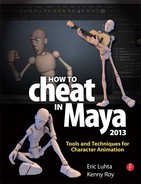How to Cheat and Why
The truth about cheating
When we hear the word “cheating,” we usually think of something negative: deception, trickery or chicanery. However in this book, cheating is a good thing. If you've watched someone who's a master of something work at it, it can seem unreal, almost like they're… cheating! But really they just have experience and in-depth knowledge of how to achieve something. They know the most efficient way to do a task and make their tools work for them.
That's the goal of this book: to give you in-depth knowledge of animating with Maya so you can skip over the trial and error, constant web searches, and poring over internet forums. Since Maya can be a technical minefield of complex menus and settings, you need someone to help you navigate this sophisticated program and get right down to the most important thing: performance. When it comes down to dodging discouragement, avoiding adversity, and side-stepping setbacks, you want all the cheats you can get! Our goal is for you to come to view this book as your on-hand reference guide as you study the art of motion.
The philosophy
Throughout our teaching experiences, one of the methods we found to be extremely effective in quickly transferring knowledge to someone else was isolation of a concept: really honing in on a single task and practicing until the knowledge is engrained. This may seem obvious but it's rare to come across an animator who didn't learn by studying performance while simultaneously wrestling all of the technical concepts. Although trial by fire can be an effective learning method, it makes for some very discouraging times. This books takes an approach that will give you a firm grasp on the technical concepts of animation, one at a time.
You will understand how to employ Maya's tools faster and concentrate on making your animation look amazing, rather than why that prop keeps popping out of the character's hand.
As luck would have it, the How to Cheat series is perfect for this style of learning. Every page spread is geared toward a specific concept, which allows you to go through the book cover to cover, or skip around to the things you want to know about. The choice is yours.
Scene files and examples
Just about all of the topics have an accompanying scene file. Most of the topics enable you to follow along, employing the given technique in a prepared animation. Once you understand the technique and have practiced using it in an animation, it will be very easy to transfer it over to whatever you're working on. For chapters that are one long project, scenes are included in a progressive order, so you can jump in anywhere and learn what you want to learn without having to start at the beginning. Having the scene files for an animation book should prove extremely useful, as you can take a look under the hood and examine the curves and see the movement for yourself. As great as books can be, you really have to see an animation in motion in the end.
Throughout the book, we use multiple character rigs that have been stress tested by students and veterans alike. We've found them to all be very fast, stable rigs, and all have just the right number of advanced features without getting too complicated.
The scene files are included for Maya 2013. If you're using an older version of Maya, just have “Ignore Version” checked in the File > Open options.
What you need to know
While this book starts at the beginning as far as animating is concerned, it does assume a basic knowledge of getting around Maya. You should be able to navigate the viewports (orbit, pan, dolly in 3D space), understand the interface, and be comfortable using the move, rotate, and scale tools. This information is covered in countless places on the web and in other materials, and we'd rather keep the book focused than rehash what's easily found elsewhere.
Going further
Visit the book's website at www.howtocheatinmaya.com. There you can find all the scene files for using the book, as well as previous material from the 2010 and 2012 editions that couldn't be included here due to space. Happy animating!
Eric Luhta
Kenny Roy
